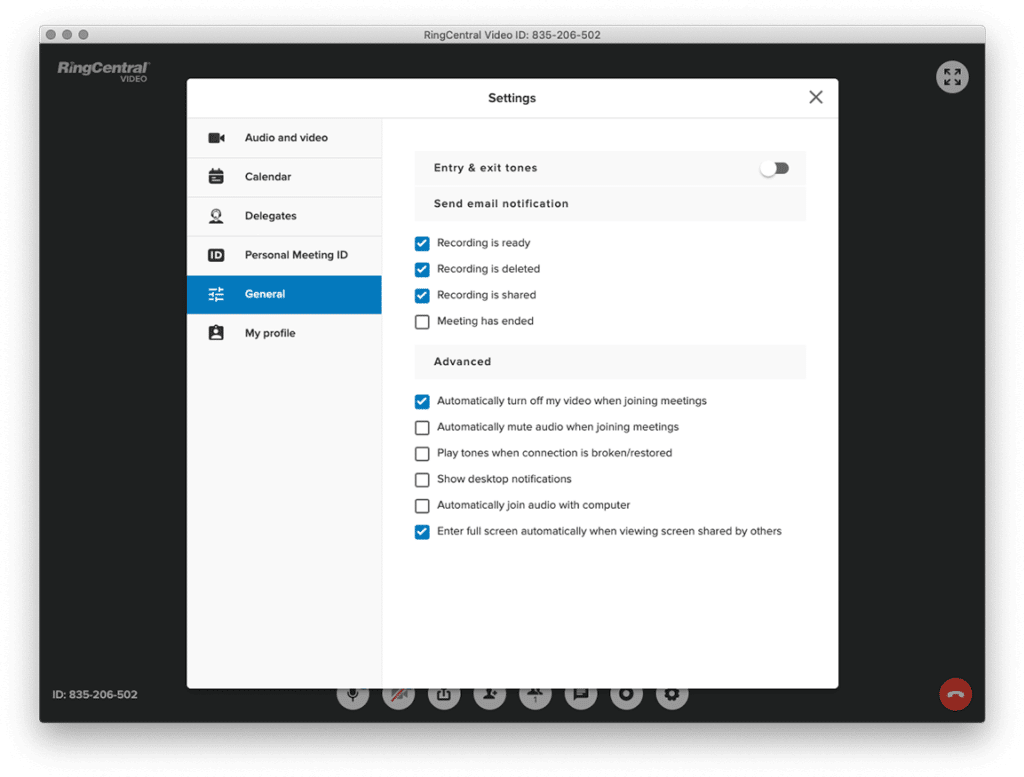Want to have more meaningful meetings?
Then it’s time for your business to prioritize face-to-face communication.
Rather than send forgettable emails or messages that get buried in inboxes, face-to-face interactions demands people’s attention.
And sure, doing so is easier said than done if you’re juggling a busy schedule or working remotely. This is especially true with COVID-19 keeping us apart from clients and coworkers.
That’s exactly why conference call services are so valuable for companies today. Video meetings empower you to have face-to-face interaction without wasting time or putting folks at risk.
In this guide, we’ll teach you how to have an effective meeting and why face-to-face communication is crucial to making those meetings count.
We’ll go over:
- What is face-to-face communication?
- Why face-to-face meetings are so important
- Which meetings don’t need to happen face-to-face
- 5 essential skills for face-to-face communication in business
🔍 Are you thinking about purchasing a new communication tool and unsure how to get started? Here’s a checklist to help you pick the right one for your business.
What is face-to-face communication?
Face-to-face interaction represents in-person conversations where participants can see each other. This includes in-person conversations (think: one-on-one meetings, stand-ups, conference room sessions) and video meetings through tools (like RingCentral):

Meeting face-to-face is a must-do for companies including, of course, distributed and remote teams. That’s because in-person conversations are more memorable as they allow attendees to pick up on non-verbal cues, body language, and emotions that are difficult to replicate via text.
Ask yourself: when’s the last time you reflected on an email or chat message?
The mere act of meeting face-to-face goes hand in hand with building relationships with customers and coworkers alike.
Face-to-face communication is crucial in business, and it’s often a balancing act. When you’re juggling tasks and your schedule is tight, it becomes clear that not every meeting requires an in-person conversation.
After all, email isn’t going anywhere and team messaging is all the rage right now. You have plenty of options in terms of how they communicate (as long as face-to-face interaction don’t fall by the wayside).
Why are face-to-face meetings so important?
Fair question! Below are some of the key benefits of face-to-face communication and when it makes sense for teams compared to traditional messaging.
People are likelier to learn and retain information from your conversations
Fact: studies show that face-to-face interactions go hand in hand with understanding and engagement.1
When people have the ability to see who they’re talking to, they’re more likely to retain what they’re hearing. Many people are visual learners, plus in today’s distracted world, face-to-face communication forces people to pay attention to the conversation at hand.
Imagine you’re replacing your car battery for the first time. You’d probably prefer to watch a video of someone walking you through the process versus someone just reading you the steps, right?
Face-to-face conversations create personal connections
According to Gallup, personal connections are essential to success for workers in remote environments.2
Building a sense of trust among your coworkers is difficult through text alone. Beyond combating workplace loneliness, face-to-face interaction serves as a reminder to your coworkers of the faces behind the keyboard.
This sort of personal connection is important for serving customers, too. Rather than communicate solely through email, getting some face-time or following up with them in-person shows that you’re invested in their success.
Also consider that there are personal or sensitive situations where face-to-face communication is much more personable.
For example, the popularity of telehealth and virtual therapy speaks to how patients need to see their doctors to feel comfortable going back and forth with them. Here are some other situations where face-to-face interaction is appropriate:
- Providing personal, one-on-one conversations with teammates (think: a performance review)
- Discussing potentially sensitive workplace information
- Wanting someone’s undivided attention (think: talking about leaving a company, etc.)
You empower customers and teammates to tackle complex issues
In short, some issues are just too complex for a quick call or email.
And research shows that when issues become complicated, customers are 23% more likely to seek out face-to-face interactions versus rely on a phone call or self-service options.3
This is a prime example of how features in RingCentral, like screen sharing, allow for face-to-face interaction to help clarify issues for your customers. The same rings true for walking coworkers through a detailed report, for example:

The ability to show versus tell, and give your teammates an opportunity to ask questions face-to-face will ultimately encourage them to learn more effectively. If nothing else, talking to them face-to-face makes it more likely they’re paying attention to you.
Which meetings don’t need to happen face-to-face?
Let’s be real, though: not every conversation needs to be a face-to-face meeting—sometimes a simple virtual call is plenty.
People are busy. Not only do you need to respect the schedules of others, but you should also consider your own!
Although some conversations make more sense to have in person, here are some sample situations that are often better suited for messaging compared to face-to-face interactions:
- Simple “yes” or “no questions to your team
- Requesting access to a file, document, or resources
- Check-ins on the status of a project
- Reminders to complete a task (think: fill out a form, sign a document)
- Sharing reports or spreadsheets that can be shared or viewed digitally
These common workplace conversations can easily be handled in a team collaboration software. This way, you can instantly take care of the “small stuff”—and free up time in your schedule to meet with your colleagues and coworkers face-to-face for the bigger, more complicated conversations:

As an added bonus, you can actually talk face-to-face directly from the RingCentral app by simply clicking the video icon to start a virtual meeting.
5 essential skills for face-to-face communication in business
To wrap things up, let’s break down the must-have for running better meetings that center around face-to-face interaction.
1. Preparedness
Remember what we said earlier about respecting everyone’s schedules?
It might be a no-brainer, but anything you can do to make your meeting start on time is a plus.
This means having an agenda that outlines where (and when) your meeting will be as well as who will be doing the talking. If you need your attendees to do homework or present something themselves, make sure they aren’t blindsided by those requests.
Oh, and preparedness also means double-checking your video conferencing software to avoid any needless hiccups once you actually get started. The good news is that tools like RingCentral make it a cinch to make your meetings run smoothly, allowing you to preview your video, mic settings, and files in a single click:

2. Looking the part
Right now most of us are rocking work-from-home attire, which isn’t going to win many “best dressed” awards.
Getting into business casual mode is one easy way to give your meetings a subtle sense of professionalism.
When in doubt, make a point to look your best—especially if your meetings are in HD video. That means every detail of your wardrobe and lighting are crystal clear for your attendees. (This again speaks to the need to preview your video settings prior to getting started.)
Keep in mind that much of “looking the part” also involves your body language.
For example, are you making eye contact with your camera? Are your attendees’ eyes veering off the screen? Is anyone slouching?
Picking up on attitudes and emotions is one of the biggest benefits of face-to-face interaction, granted you’re paying attention to them.
3. Organization
Another important piece of virtual meeting etiquette: don’t try to spring face-to-face meetings on your coworkers without some sort of heads-up. Remote work doesn’t necessarily mean that everyone’s schedule is a total free-for-all.
Ideally, you should be able to see your attendees’ availability on their calendars to zero in on a time that works for everyone. This is what doing so looks like through RingCentral’s integration with Google Calendar:
4. Brevity
It’s easy for a face-to-face conversation to devolve into tangents and small talk if you aren’t careful. For the sake of respecting everyone’s time, try to keep your meetings brisk and stick to your talking points instead of going off script too often. (This will also make sure that you hold your attendees’ attention.)
If there’s still time left after you’ve gotten through the “meat” of your meeting, then of course, you can have those off-the-cuff conversations.
5. Attentive questioning
Both during and after meetings, make a point to pause and make sure that everyone is on the same page.
Something as simple as “Any questions?” or “Did everyone get that before we move on?” can encourage meaningful conversations that get people talking. When someone has their concerns relayed back to them, they know they’re being heard and even more so when the conversation is happening face-to-face.
Are you prioritizing face-to-face communication?
So much of how to have an effective meeting involves getting some face time in.
Rather than live exclusively in your inboxes, make a point to initiate more frequent face-to-face interaction.
If it’s not possible to meet in person right now, remember that there are tools that can help you! If you aren’t using RingCentral already, see how it can help you conduct more engaging and productive virtual meetings:
🕹️ Get a hands-on look at how RingCentral can help you improve your face to face communication by booking a product tour:
1 burleigh-court.co.uk/assets/docs/face-to-face-communication.pdf
2 gallup.com/workplace/311288/communicate-create-stability-despite-uncertainty.aspx
3 comm100.com/resources/report/2017-live-chat-benchmark-report
Updated Mar 13, 2025











